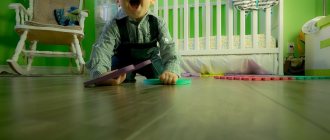After birth, parents often worry about how the baby feels in a new world.
The small face of a newborn still looks rather inexpressive.
Infants may squint their eyes and look indifferently to the sides. Inexperienced parents accept such signs as a pathology and seek help from an ophthalmologist, but for a newborn and infant this view is considered the norm. Children see only a fuzzy picture of the world around them in black and white. But the fact that newborns have inverted vision is a myth.
Stages of development and formation of vision by month
Small children cannot distinguish objects; newborns' vision is blurred and unclear.
First month of life
The visual abilities of an infant from the 1st month of life differ from vision in the first days of life. The baby is already able to distinguish the faces of his parents from the surrounding world, even if against a blurred background. By the end of the 1st month, the baby learns to follow with his eyes a moving toy or other objects, but no more than 30 centimeters from his face.
Second and third month
From the 2nd month, the baby develops central vision. He already knows how to clearly fix his gaze on objects 80 centimeters from him and closer. During this period, the baby develops a two-dimensional perception of objects (distinguishes between height and width), but at the same time he does not distinguish them by volume; for him, all things are flat.
Upon reaching 3 months, the baby can already distinguish shades of colors (yellow and red), and also distinguishes contrasting patterns. In addition, a child at 3 months is already able to hold his gaze on a drawing for a long time. He develops binocular vision, thanks to which the child recognizes his parents.
Sixth month
By 6 months, the baby distinguishes many colors, focuses his gaze longer, follows movements and sees himself in a mirror reflection, but does not understand that it is him.
Formation of vision by one year
At one year of age, a child is able to clearly see at a distance of 6 meters, his level of visual acuity increases, he orients himself well in the area, thanks to this the baby can take his first confident steps.
Your baby's vision: color perception
As it turns out, newborns see the world primarily in black and white. The fact is that when a small person is born, the cells in his retina that are responsible for color have not yet fully developed. When do newborns begin to see colors? At about a month, babies can respond to the brightness and intensity of colors, and by three months, the baby begins to see several primary colors, including red. Color perception is finally formed by four months - then the baby distinguishes many colors and even their shades.
So what can newborns see? Observe how your baby reacts to colors and patterns—for example, when he looks at the mobile above the crib. You may notice that in the first month your baby will notice simple black and white patterns, wide stripes, or patterns with contrasting colors. By the time he's three months old, he'll probably be interested in patterns with flowing lines, like spirals or radiating circles.
Month after month, the baby learns new things, and together with him, his parents rejoice at his new skills and achievements. If you're interested in learning about what happens as your baby gets older, read about the developmental stages of babies from four to nine months. If you have questions or concerns about your child's vision, be sure to contact your doctor.
Diagnosis of vision in infants
The baby undergoes the first vision examination on the first day of life by a neonatologist. The doctor can easily determine the presence of diseases of the organs of vision (if any). But it is important to know that most eye diseases make themselves felt only a month after birth, so at this age the baby undergoes a routine examination by an ophthalmologist. The doctor carefully examines the visual system:
- determines eye shape, size;
- condition of the sclera;
- reflexes;
- pupil position.
A follow-up appointment with an ophthalmologist should take place no earlier than 6 months after birth (unless there is an urgent need for an appointment). If the baby was born a couple of weeks ahead of schedule, an appointment is scheduled every three months.
How does vision change in children under one year old?
So, what stages of formation does a child’s visual apparatus go through? What can and should a baby distinguish, what should it react to, how does the vision of newborn children change by month?
- 1 month: where is he looking?
At this age, the baby is able to distinguish between light and shadow, the outlines of large objects at a distance of no more than 30 cm. Wise nature designed it so that in the initial days of his life the child more clearly sees the most important thing - the mother’s face, her smile, it is at this distance that it is located during feeding. Everything else doesn't matter to him yet. At a further distance, objects look blurry to him, since visual acuity has not yet been formed. During this period, it is recommended to take the child in your arms more often during his waking moments and talk to him. It is important to check how the pupil reacts to light. The ophthalmologist will do this during your first visit.
- 2-3 months: life in bright colors
In the first 2-3 months of life, the light sensitivity of the retina will increase almost five times and the visual apparatus is actively developing. The extraocular muscles are strengthened. The baby already more confidently fixes his gaze on a horizontally moving object (toy, person) and turns his head behind it, but it is still difficult for him to catch vertical movement. It more clearly distinguishes the outlines of objects, but so far they are visible in two dimensions: length and width. At the same time, the world begins to be filled with more and more diverse colorful shades. At this age, newborns can already distinguish between red and green. Cool (blue, cyan) shades will become available later, since there are fewer photoreceptors in the retina that capture the short-wave part of the spectrum. Hang the mobile above the crib at a distance of 40-50 cm - it helps strengthen the ciliary muscles, as the baby follows objects by moving his eyes.
It is also recommended to carry the child around the apartment, show objects and name them. The baby also recognizes the faces of loved ones that it sees all the time.
- 4-6 months: grab it, or it will run away!
From three months of life to six months, children's vision continues to actively develop. The formation of the macula occurs - the zone of the retina responsible for central vision, visual centers in the cerebral cortex. The child can already clearly distinguish the parents’ faces, facial features, and facial expressions. The most exciting activity for him during this period is playing with his own hands and feet. In addition, along with the visual function, the grasping reflex also develops, since the baby is interested in exploring a clearly visible object. 4-6 months is an important period; parents need to be especially careful. By this time, infant strabismus should have passed, since the extraocular muscles are already working quite well. If this does not happen, then you need to urgently visit an ophthalmologist and conduct a thorough examination. In addition, during the same period, the doctor must examine the condition of the visual organs and finally make sure that there are no obstacles to their further development (congenital glaucoma, retinopathy of prematurity, etc.).
- 7-12 months: exploration of space
This is the period of development of motor activity: the baby actively crawls, moves in a walker, tries to take the first independent steps, holding on to furniture. He begins to understand the difference in the shape of objects (for example, he distinguishes between a cube and rings), strings rings on the axis of a pyramid, in a word, he actively learns about objects and distances (an aspect of assessing the distance of binocular vision). During this period, you should be especially careful, since the child causes many injuries to himself, grabbing everything and trying to put it in his mouth, as well as falling from the sofa or bed.
Is it possible to check a child’s vision yourself?
Upon reaching 3 years of age, a child’s vision can be checked at home. The Orlova table is the most popular home examination method. The table does not show familiar letters, but images of animals, since at 3 years old a child cannot yet know the alphabet.
The Orlova table is a method of testing vision, but for this you need to make printouts of the table, then place it on the child’s eye line in a lighted room.
To check the functionality of a child’s vision at home, you must use the following recommendations:
- Before starting a vision test, you need to familiarize your child with the table and ask him to list all the pictures on it. This must be done, because this way the child will understand what is required of him.
- Testing vision at home causes eye fatigue in children much earlier than when examined by a doctor. In this case, it is better to start the study from the top of the table, showing only one picture from the row.
- During the test, one eye must be closed.
- It is necessary to ensure that the child does not squint and can give the desired answer within 5 minutes.
To check the level of visual acuity of a schoolchild, a different method should be used. All school-age children know the alphabet, which means that Sivtsev’s table can be used. It is the most popular for vision testing in medical institutions; in addition, it gives fairly good results. The table has the same structure as Orlova’s table, but instead of pictures there are letters. In this case, it is used according to the same principle:
- ask the child to move away to a distance of 5 meters and cover one eye with the palm of his hand;
- after that ask him which letters are in the 10th row;
- if the student answered everything without errors, then there are no deviations;
- eyes are checked one by one.
You can make a similar table yourself by printing it on good quality paper. An A4 sheet of paper will do.
How vision develops
Knitted envelopes for newborns with a pattern
The stages of vision development in a newborn can be divided monthly. It develops constantly, like all body systems. This means that new skills and achievements are constantly appearing.
Vision Development Chart
All norms are quite conditional - it is impossible to calculate such an important point as the individuality of each child. How a baby's ability to see develops on average is shown in the table below.
Norms of vision development in newborns by month
| Newborn | Vision is characterized by blurred, indistinct, black and white colors. |
| 1 month | The world is becoming clearer. The baby begins to distinguish large details of objects at a distance of 20-30 centimeters. The colors are still missing. |
| 2 months | Focusing develops. Vision is still black and white. The baby may try to concentrate on an object a couple of meters away from him; his vision is still unclear. The ability to follow an object slowly moving left and right appears. |
| 3 months | Image clarity is improved. Colors begin to differ, primarily red. There are attempts to coordinate your movements with what you see (for example, the desire to grab a rattle that the child is looking at). |
| 4 months | Objects in the distance become increasingly clear. Other colors begin to appear, color perception improves. |
| 5 months | An important milestone is the development of spatial depth perception. That is, now the baby will try to follow not only objects moving from side to side, but also those moving from him and towards him. Clarity of vision also improves along with alertness. The baby can also see small details. |
| 6 months | By six months, color perception is almost formed. The baby distinguishes all colors and even many of their shades. You can start getting to know them, as many teachers suggest. |
| 7 months | The vision of a seven-month-old baby is already almost fully formed. He knows how to see objects in the distance, notes the difference in all colors, and knows how to process information coming from the visual channel. |
| 8 months | Analytical skills improve. For a child, people begin to be divided into known and unknown. The baby carefully examines the adult’s face. Realizing that there is a stranger in front of him, the baby may burst into tears. When he sees his parents, he will express joy. |
| 9-10 months | The clarity becomes higher, more and more shades are distinguished. |
| 11 months | Around this age, an interest in observing the constant changes in colors and shapes appears. Therefore, many children begin to enthusiastically follow what is happening on the TV screen, tablet, or phone. |
| 12 months | The baby's vision development is almost complete. |
An example of how children of different ages see the same toy
Eye care rules
The care algorithm is as follows:
- Wash your hands thoroughly.
- Pour water into a baby bowl. Place it near the place where you wash.
- Place the baby on a flat surface.
- Dampen a cotton ball and squeeze out excess water.
- Wipe the eye from the temple to the nose.
- Replace the cotton pad and do the same with the second eye.
- To remove any remaining moisture, dry your eyes with a dry, sterile cloth.
- It is strictly forbidden to use other liquid products instead of water.
How vision develops in newborn babies
A baby's eyes begin to develop in the womb, during the third week of pregnancy. Active formation of the visual apparatus continues for several years after birth. During this period, it is important to pay attention to the child’s vision, know the stages of its development, and regularly visit the ophthalmologist for checks. Let's talk about this in more detail.
Correct formation of the visual apparatus is important for the full mental development of the baby, because the eyes are connected to other senses. With poor vision, a child will lag behind in school and experience difficulties with active activities (sports, outdoor games), so good vision not only helps to understand the world around us, but also contributes to the full development of the child.
Most vision problems can be eliminated in early childhood: the later the pathology is detected, the more difficult it is to correct and treat. It is very important to keep this aspect under control in the initial period of a baby’s life. Parents of newborn children should know the main stages of formation of the child’s visual apparatus.
Vision in newborns in the first days of life
How does a baby see in the first days of his life? Of course, not at all like an adult. The fact is that his eyeball still has a flattened shape and continues to actively grow, the retina is not fully formed, and the yellow spot, responsible for the acuity of central vision, is completely absent. The baby is not yet able to see clearly and three-dimensionally, focus his gaze on objects, or evaluate visual images. What functions are available to it?
Immediately after birth, the baby is bombarded with a huge amount of visual stimuli: from the darkness he finds himself in the bright world around him. But the vision of newborns in the first days of life is still very imperfect. Children at this time have infantile strabismus, which should go away after a certain time (we will talk about this below). The child's eyes look slightly in different directions or are reduced to the nose, since the ciliary muscles are still weak and their movements are not coordinated.
In the first days of life, infants perceive black and white images, and colors are still indistinguishable to them. The first color that a child begins to distinguish is red, since it has the longest wavelength in the spectrum, 620-780 nm. Therefore, it is recommended to buy the first toys and rattles in red.
It is also not recommended to completely turn off the lights in the room where the baby sleeps. It is better to leave the lamp working. The child, upon waking up, will begin to look for a light source with his eyes, which, firstly, will calm him down, and secondly, will contribute to the development of the oculomotor muscles.
How does vision change in children under one year old?
So, what stages of formation does a child’s visual apparatus go through? What can and should a baby distinguish, what should it react to, how does the vision of newborn children change by month?
• 1 month: where is he looking?
At this age, the baby is able to distinguish between light and shadow, the outlines of large objects at a distance of no more than 30 cm. Wise nature designed it so that in the initial days of his life the child more clearly sees the most important thing - the mother’s face, her smile, it is at this distance that it is located during feeding. Everything else doesn't matter to him yet. At a further distance, objects look blurry to him, since visual acuity has not yet been formed. During this period, it is recommended to take the child in your arms more often during his waking moments and talk to him. It is important to check how the pupil reacts to light. The ophthalmologist will do this during your first visit.
• 2-3 months: life in bright colors
In the first 2-3 months of life, the light sensitivity of the retina will increase almost five times and the visual apparatus is actively developing. The extraocular muscles are strengthened. The baby already more confidently fixes his gaze on a horizontally moving object (toy, person) and turns his head behind it, but it is still difficult for him to catch vertical movement. It more clearly distinguishes the outlines of objects, but so far they are visible in two dimensions: length and width.
At the same time, the world begins to be filled with more and more diverse colorful shades. At this age, newborns can already distinguish between red and green. Cool (blue, cyan) shades will become available later, since there are fewer photoreceptors in the retina that capture the short-wave part of the spectrum. Hang the mobile above the crib at a distance of 40-50 cm - it helps strengthen the ciliary muscles, as the baby follows objects by moving his eyes. It is also recommended to carry the child around the apartment, show objects and name them. The baby also recognizes the faces of loved ones that it sees all the time.
• 4-6 months: grab it, or it will run away!
From three months of life to six months, children's vision continues to actively develop. The formation of the macula occurs - the zone of the retina responsible for central vision, visual centers in the cerebral cortex. The child can already clearly distinguish the parents’ faces, facial features, and facial expressions. The most exciting activity for him during this period is playing with his own hands and feet. In addition, along with the visual function, the grasping reflex also develops, since the baby is interested in exploring a clearly visible object.
4-6 months is an important period; parents need to be especially careful. By this time, infant strabismus should have passed, since the extraocular muscles are already working quite well. If this does not happen, then you need to urgently visit an ophthalmologist and conduct a thorough examination. In addition, during the same period, the doctor must examine the condition of the visual organs and finally make sure that there are no obstacles to their further development (congenital glaucoma, retinopathy of prematurity, etc.).
• 7-12 months: exploration of space
This is the period of development of motor activity: the baby actively crawls, moves in a walker, tries to take the first independent steps, holding on to furniture. He begins to understand the difference in the shape of objects (for example, he distinguishes between a cube and rings), strings rings on the axis of a pyramid, in a word, he actively learns about objects and distances (an aspect of assessing the distance of binocular vision). During this period, you should be especially careful, since the child causes many injuries to himself, grabbing everything and trying to put it in his mouth, as well as falling from the sofa or bed.
Binocular vision of newborns
Binocularity is a property of vision in which the image on both retinas is combined into one three-dimensional image. Binocular vision also helps to determine the shape of objects, the distance to them or between them. In its absence for any reason, the child develops pathologies: strabismus, amblyopia, myopia and others.
In the period up to one year, active development of near space occurs - an important stage in the development of binocular vision. At two or three months, the baby still sees objects in two dimensions (width and height), but the sense of touch helps him supplement them with volume (adding depth). The child gets the first idea of the volume of objects.
At 4-5 months of life, the grasping reflex develops, and the direction of movement is determined correctly, but there are still difficulties in assessing the distance to an object. Also, the baby is not able to fully appreciate the volume: he tries to grab the sun's glare or moving shadows with his hands.
After six months, the exploration of distant space begins. The tactile reflex replaces active crawling, and after 10 months - walking. At the same time, the child learns to estimate the distance to the object to which he is moving, and there comes an understanding that it is possible to fall from the edge of the bed.
Binocular vision in newborns immediately after birth is still absent due to the unformed ocular apparatus. But at 6-8 weeks he should already be able to fix his eyes on an object; at 3-4 months this should become the norm. Parents should pay special attention to this.
Color vision in the first year of life
Color vision is formed thanks to cones - special color receptors in the eyes. They perceive spectrum waves of a certain length, and the brain interprets these signals. Babies' brain cells begin translating these signals around two months. At first, children are able to perceive red, yellow, bright green colors - those that have a longer wavelength. Only later, by six months, does the baby recognize the color blue. Disorders associated with the lack of color vision can only be identified when the baby learns to understand the meaning of words and can show with his finger where the color is red and where the green is. In general, children under one year old have four color categories: red, yellow, blue, green. They begin to understand shades such as pink or purple as their speech develops.
What needs to be done to help the correct formation of vision in newborns?
During the period of active formation of the visual apparatus up to a year of a child’s life, his children’s room should be properly decorated. You should not glue wallpaper that is too colorful. It is better to place bright objects of different colors and sizes, from different materials, against a neutral background. These can be purchased toys, homemade ones, or some household item; it is important that it does not cause harm to the child. By exploring objects of various shapes and materials, the baby forms stereoscopic vision, his own idea of the world around him.
You should also not overwhelm your baby with many toys at the same time. Let there be several of them, and when he begins to lose interest in them, replace them with others. With many objects, the child will grab first one or the other, without thoroughly exploring and constantly being distracted.
How to determine visual impairment in newborns?
The very first examination of the baby’s eyes is carried out in the maternity hospital for congenital diseases, then it is necessary to carry out preventive examinations at 1 month, 3 months, six months and a year. At the same time, during the growth process you should pay attention to certain factors.
• pupils of different diameters;
• pupils do not constrict in bright light;
• the child does not fix his gaze on an object after 2 months;
• strabismus does not go away after 3 months;
• frequent watery eyes or cloudy pupils.
All these are reasons for an urgent unscheduled visit to the ophthalmologist; they can be signs of dangerous pathologies. If there are hereditary eye diseases in the family or the mother suffered any serious illness during pregnancy, then special care must be taken in this case. Parents are unable to recognize some diseases, for example, retinoblastoma (retinal tumor), and when they sense something is wrong, it may be too late.
Early prevention of proper development of the visual system in children
The formation of a baby's eyes begins long before birth. Weeks 3-12 are the most important period of intrauterine development, at this time the formation of the most important vital organs and systems occurs, and the little man is very susceptible to destructive actions. Infectious disease of the mother, smoking, alcohol, taking dangerous medications, unhealthy diet can lead to adverse consequences. Disturbances in the formation of the visual organs can be caused by a lack of vitamin A (blindness), excessive administration of glucose-lowering drugs (underdevelopment of the optic nerve, congenital cataracts). Even taking aspirin can cause eye pathologies. Expectant mothers need to be especially attentive to their health.
Come for a diagnosis at the Kazakh Research Institute of Eye Diseases at the address: Almaty, Tole bi street, 95a (corner of Baitursynov street). Telephone; +7 (727) 279 54 36
Help and accelerate vision development
In the first month of life, the child learns to focus his vision on the silhouettes of his parents, bright toys and pictures.
The more a child receives various motor and visual information from the world around him, the faster the brain develops. In addition, the work of temporal-spatial thinking and a clear perception of the objects surrounding the baby begins.
Drawings for the rapid development of the visual system in the first month of life
From the very first days until the age of 6 months, it is imperative to use various methods to develop the child’s visual skills. It is for the first 6 months that the baby experiences active growth and development of the visual organs, descending and ascending tracts. They direct all information from the eyes to the cerebral hemispheres, where active processing of the received data occurs and the formation of reverse motor and emotional responses.
Black and white pictures can be placed above the crib so that the baby can look at them every day. If a bright baby mobile is installed on the lullaby, it must be replaced with a large black and white one. Moreover, if the design of such a mobile provides illumination, it should not be too bright. To buy a suitable mobile phone, you need to consult with a pediatric ophthalmologist or sales consultant in the store.
Lesson for a child from 3 months
For this lesson you will need a picture with various drawings; it should be kept at a distance of 40 centimeters from the baby’s eyes. Immediately, as soon as the child focuses his gaze on a certain drawing, you need to carefully move the sheet a little to the side, stopping within 60 centimeters from the face. To make your lessons more effective, you need to hang several black and white pictures in the children's room.
Lessons from 4 months
For this exercise you will need several bright drawings that need to be placed in front of the child’s eyes. Gradually you need to move the picture to one side, and then two at once, waiting for the baby to clearly fix his gaze on the picture.
When does a child's gaze focus?
How much water to give a formula-fed newborn
Parents are interested in when newborns' eyes focus. You should not wait for this immediately after childbirth. Everything develops gradually:
- The child will make his first attempts to strain his vision around the first month of his life, but only on an object or person at a distance of 20-30 centimeters from his eyes. It is then that the baby begins to distinguish between the eyes and mouth, the largest parts of the parents’ faces, most often bent over the baby.
- By the age of two to three months, the focusing range increases to a couple of meters. Now the baby can see the rattle lying a step away from him.
- By four months, the baby will notice even more distant or small details: he will be interested in a picture on the wall or the view from the window.
- In the period of 7 months to a year, the baby learns to focus his gaze in the same way as an adult, if there are no disturbances in the development of the visual system.
Interesting. When a newborn baby's vision focuses, he examines what he sees for a long time and carefully. This is how the baby gets acquainted with the world and learns to process a new flow of information. Later, when his motor skills allow him to touch and grab the desired object, he will not only examine it, but also touch, twist, lick, and gnaw.
Newborn exploring a toy
Prevention of pathologies
For preventive measures of vision diseases in children, it is allowed to use the following recommendations:
- Daily eye exercises for children over 3 years old.
- Encourage your child to play sports as early as possible. Physical activity can strengthen the visual system.
- Wash your child with slightly cool water several times a day; it helps normalize blood circulation in the retina.
- Give your baby daily vitamin and mineral complexes prescribed by your doctor.
- Monitor your sleep, it should be at least 8 hours a day.
- And, of course, walks in the fresh air.
Prevention of eye diseases in children should be carried out in a playful way, and not as coercion or punishment. The importance of these rules must be explained to the child and, if possible, carried out in the form of a game.
Prevention of proper development of the visual apparatus
In order for a baby’s vision to develop correctly, this should be taken care of even before the ophthalmologist detects pathologies. Well-known pediatrician Evgeny Komarovsky recommends doing this:
- Ensure sufficient lighting in the children's room during periods when the child is awake. Otherwise, he will learn to identify colors later, and it will be worse to distinguish shades.
- Toys must be large and contrasting. Delicate shades, so beloved by mothers, worse develop the baby’s color perception. In the first half of the year, Evgeniy Olegovich recommends paying more attention to green and yellow shades, but other colors should also be present in the baby’s everyday life.
- The popular toy mobile should not be hung directly above the baby’s head, but slightly to the side. For the first three months, the baby will not be able to see any objects at a distance of 40 cm above the face. Such close proximity can provoke the development of strabismus.
Correctly positioned mobile on the crib
Other pediatricians and ophthalmologists supplement Komarovsky’s list with the following recommendations:
- For the first two months of life, it is better to use black and white toys. When a newborn's vision first focuses, it is better for the objects around him to have as much contrast as possible.
- Avoid directing bright light into the baby's face (except when visiting an ophthalmologist). This is unpleasant and puts strain on the child's eyes. If we are talking about walks in the summer, at the height of the day, then it is better to raise the hood of the stroller so that the shadow falls on the face. In indirect sunlight (for example, in the evening), this may not be necessary.
- Work with a newborn. It is recommended that the mother lean over him more often, talk, and let the baby study her face. Dad should do the same. As the child grows up, simple games with a rattle are added. By three to four months, you can give glowing toys.
- On the street, during periods of wakefulness, from three months onwards, the baby can be picked up, approached, for example, by trees, and allowed to look at them.
The best prevention for the proper development of vision in a newborn is the attention of parents to their child, as well as compliance with all medical recommendations. In this case, the chance of the baby developing a serious pathology is significantly reduced.










